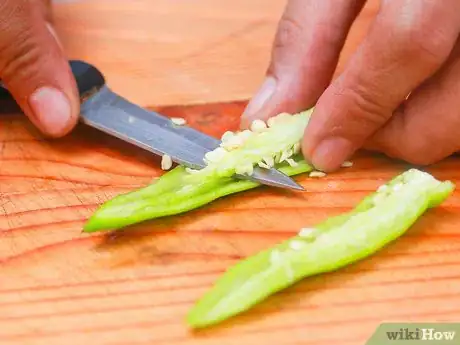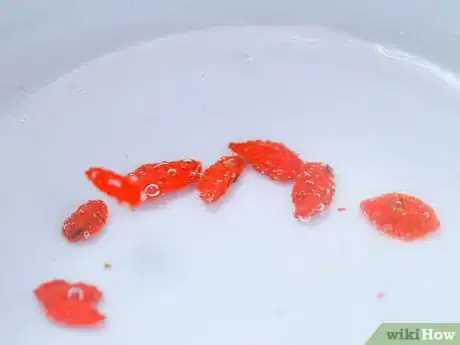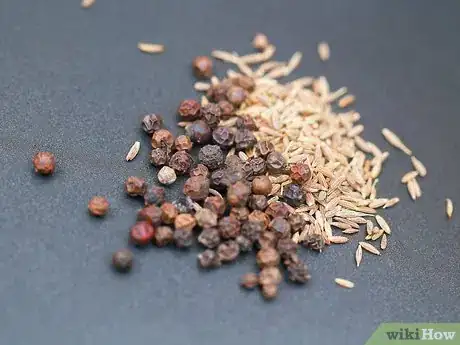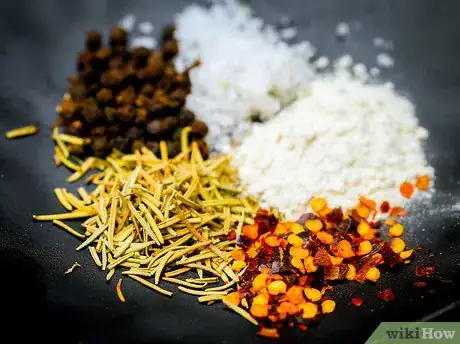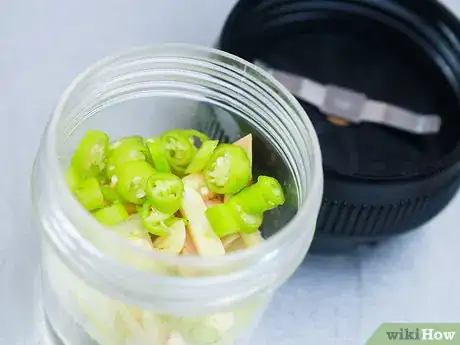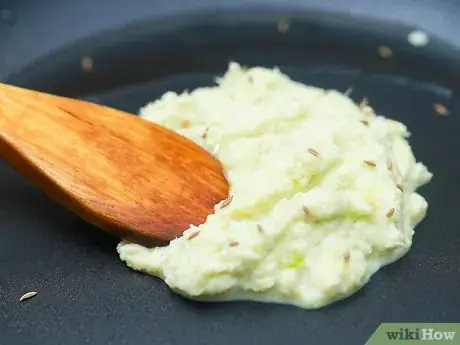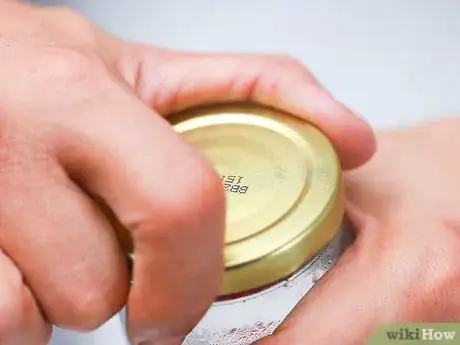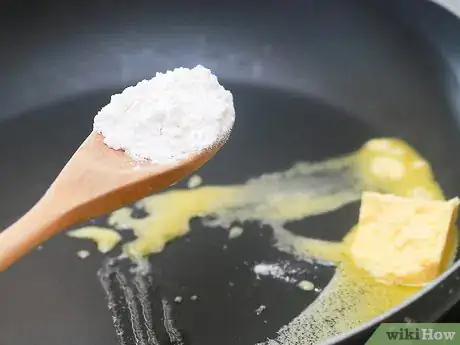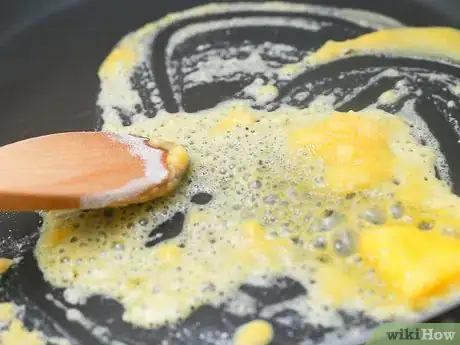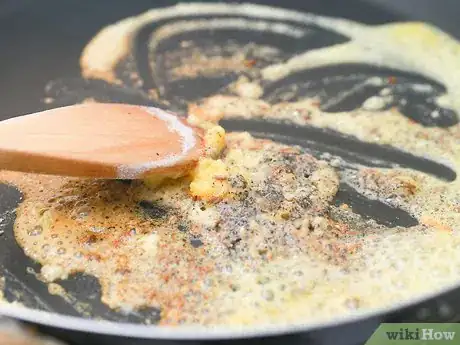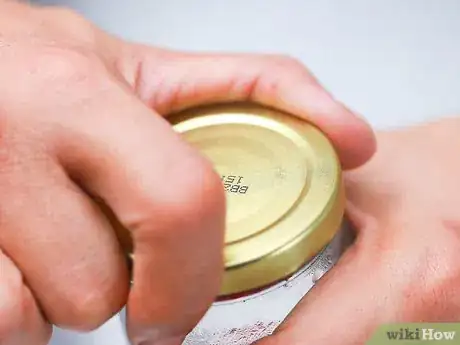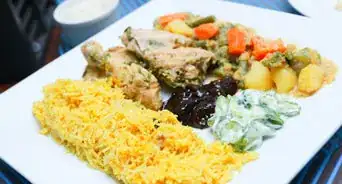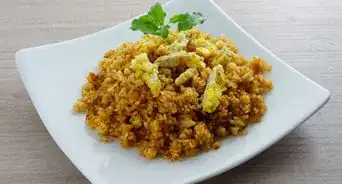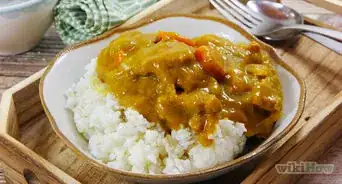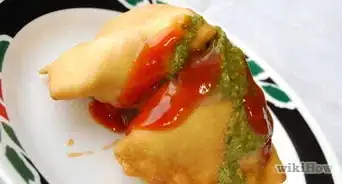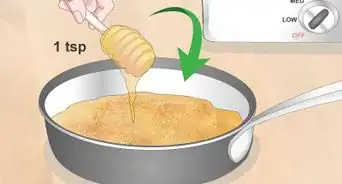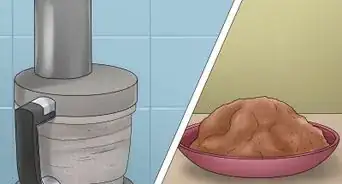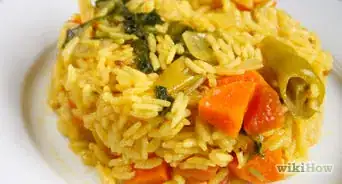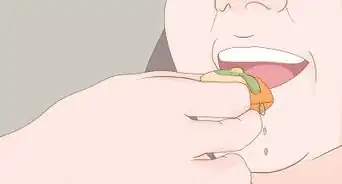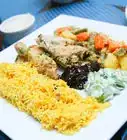wikiHow is a “wiki,” similar to Wikipedia, which means that many of our articles are co-written by multiple authors. To create this article, volunteer authors worked to edit and improve it over time.
This article has been viewed 37,126 times.
Learn more...
There are many different curry pastes you can make. While the ingredients vary, the steps you need to take when preparing them are nearly identical for each recipe. The only time you can expect the instructions to completely change is when you are preparing a curry roux, which combines curry spices with butter and flour.
Ingredients
Korma Curry Paste
Makes 1 cup (250 ml)
- 2 garlic cloves
- 1 thumb-sized piece of ginger
- 1/2 tsp (2.5 ml) cayenne pepper
- 1 tsp (5 ml) garam masala
- 1/2 tsp (2.5 ml) sea salt
- 2 Tbsp (30 ml) groundnut oil
- 1 Tbsp (15 ml) tomato puree
- 2 fresh green chiles
- 3 Tbsp (45 ml) desiccated coconut
- 2 Tbsp (30 ml) ground almonds
- 1 small bunch fresh coriander leaves
- 2 tsp (10 ml) cumin seeds
- 1 tsp (5 ml) coriander seeds
Tikka Masala Curry Paste
Makes 1 cup (250 ml)
- 2 garlic cloves
- 1 thumb-sized piece of ginger
- 1 tsp (5 ml) cayenne pepper
- 1 Tbsp (15 ml) smoked paprika
- 2 tsp (10 ml) garam masala
- 1/2 tsp (2.5 ml) sea salt
- 2 Tbsp (30 ml) groundnut oil
- 2 Tbsp (30 ml) tomato puree
- 2 fresh red chiles
- 1 small bunch fresh coriander leaves
- 1 Tbsp (15 ml) desiccated coconut
- 2 Tbsp (30 ml) ground almonds
- 1 tsp (5 ml) cumin seeds
- 1 tsp (5 ml) coriander seeds
Vindaloo Curry Paste
Makes 1 cup (250 ml)
- 2 garlic cloves
- 1 thumb-sized piece of ginger
- 4 dried red chiles
- 1 Tbsp (15 ml) turmeric
- 1/2 tsp (2.5 ml) sea salt
- 3 Tbsp (45 ml) groundnut oil
- 2 Tbsp (30 ml) tomato puree
- 2 fresh red chiles
- 1 small bunch fresh coriander leaves
- 1 tsp (5 ml) black peppercorns
- 4 whole cloves
- 2 tsp (10 ml) coriander seeds
- 2 tsp (10 ml) fennel seeds
- 1 tsp (5 ml) fenugreek seeds
Madras Curry Paste
Makes 1 cup (250 ml)
- 1 medium onion, peeled and quartered
- 4 large garlic cloves, peeled
- 2 jalapeño peppers, seeded and halved
- 1-1/2 inch (3.8 cm) fresh ginger, peeled and cut into chunks
- 2-1/2 Tbsp (37.5 ml) Madras curry powder
- 2 tsp (10 ml) ground coriander
- 1 tsp (5 ml) ground cumin
- 1 tsp (5 ml) ground chili powder
- 1/2 tsp (2.5 ml) ground turmeric
- 1/2 tsp (2.5 ml) mustard powder
- 1/2 tsp (2.5 ml) ground black pepper
- 1/4 tsp (1.25 ml) coarse salt
- 2 Tbsp (30 ml) apple cider vinegar
- 2 Tbsp (30 ml) vegetable oil
Basic Thai Curry Paste
Makes 1 cup (250 ml)
- 3 shallots, roughly chopped, or about 1 cup (250 ml)
- 2 stalks fresh lemongrass, thinly sliced, or about 1/3 cup (85 ml)
- 5 garlic cloves, peeled and roughly chopped, or about 1/4 cup (60 ml)
- 2 inches (5 cm) fresh ginger root, peeled and chopped, or about 3 Tbsp (45 ml)
- 2-1/2 Tbsp (37.5 ml) coconut milk
- 1-1/2 Tbsp (22.5 ml) Thai fish sauce
- 2 tsp (10 ml) light brown sugar
- 2 tsp (10 ml) ground coriander seeds
- 1 to 2 small red Thai chile peppers, seeds removed OR 1-1/2 tsp (7.5 ml) dried crushed chiles
- 2 tsp (10 ml) ground cumin
- 3/4 tsp (3.75 ml) ground cardamon
- 1/2 tsp (2.5 ml) ground cinnamon
- 1/2 tsp (2.5 ml) ground turmeric
- 1/8 tsp (0.6 ml) ground cloves
Basic Malaysian Curry Paste
Makes 2 cups (500 ml)
- 4 small shallots, peeled and chopped
- 2 inch (5 cm) piece of ginger, peeled and sliced
- 18 garlic cloves
- 5 small red birds eye chiles
- 1.25 oz (40 g) fresh turmeric, peeled and sliced
- 3 oz (80 g) fresh galangal, peeled and sliced
- 8 to 10 kaffir lime leaves
- 1 Tbsp (15 ml) lemongrass paste
Basic Japanese Curry Roux
Makes 1 cup (250 ml)
- 3 Tbsp (45 ml) unsalted butter
- 4 Tbsp (60 ml) all purpose flour
- 1 Tbsp (15 ml) curry powder
- 1 Tbsp (15 ml) garam masala
- 1/4 tsp (1.25 ml) cayenne pepper
Steps
Part One: Preparing Your Ingredients
-
1Peel and toast any ginger, garlic, onions, or shallots. When these ingredients are among those called for in the recipe, you should peel off the outer skin, roughly chop the ingredient into chunky pieces, and toast those pieces on the stove.
- To peel the ingredients:
- Peel ginger by gently scraping the skin off with a spoon.
- Peel garlic by striking the clove with the flat side of your knife. The skin should completely separate from the clove. Remove it with your fingers and use the smashed garlic as is.
- Peel onions and shallots but cutting off both ends and peel the skins away with your fingers.
- Toast these aromatics by heating a skillet to medium heat and tossing them in. Stir with a spatula or heat-resistant mixing spoon for 1 to 2 minutes, or until a strong aroma is produced.
- Strictly speaking, you do not need to toast aromatics before using them. Peeling them is necessary, but the toasting process is only optional. Cooking them briefly in this matter is still recommended because it enhances both the scent and taste of the final curry paste.
- To peel the ingredients:
-
2Remove the seeds from fresh and dried chiles. If the recipe calls for actual whole chiles, you should remove any stems, ribs, and seeds. Use a sharp yet small knife to gut the chiles.
- After handling chiles, wash your hands well with soap and water. If you do not wash your hands, you may inadvertently rub your eyes and transfer the juices to the sensitive tissue there and causing a severe burning sensation.
Advertisement -
3Soak any dried chiles. Fresh chiles can be used as they are, but if your recipe calls for dried chiles, you should consider soaking them in warm water first to infuse them with some of their lost moisture.
- Tear or cut the chiles into small pieces and place them in a bowl. Fill the bowl with warm water, and let the chiles soak for 10 minutes. Drain the water before adding the chiles to the rest of your spices and ingredients.
- If you do not soak the chiles, your curry paste may lack the sort of moisture it needs to form a smooth paste.
-
4Consider toasting any whole spices.[1] When a recipe calls for whole spices instead of powdered spices, you can enhance the flavor of the final curry paste by toasting the spices on the stove before forming the paste. Doing so is only optional, but as with the aromatic ingredients, whole spices are enhanced in both scent and flavor once you use heat to draw out the essence of that spice.
- Heat a skillet on medium to high heat on the stove. Add the spices you intend to toast and keep them in the hot skillet for a few minutes, stirring almost constantly. When ready, they should take on a golden brown tint and have a notably stronger smell.
- Whole spices you might consider toasting include any nuts, seeds, and berries.
-
5Note the difference between fresh spices and dried spices. Some recipes might call for fresh spices and herbs, while others will list the dried versions. Curry paste made fresh fresh spices usually has a stronger aroma and more complex taste, but versions made with dried spices are usually just as acceptable to the common tongue. The choice is mainly a matter of preference—save the time by using dried spices or enhance the flavor profile by using fresh spices.
- If you need to convert fresh spices to dried spices, or vice versa, check on the conversion ratio for the specific spice before proceeding.
- For all herbs, use 1/3 the amount of dried herbs for every amount of fresh herb listed. For instance, 3 tsp (15 ml) of fresh parsley would equal 1 tsp (5 ml) dried parsley.
- For cinnamon, 3 inches (7.6 cm) of a stick equals 1 tsp (5 ml) ground cinnamon.
- For cloves, 3 whole cloves equal 1/4 tsp (1.25 ml) ground.
- For garlic, 1 clove equals 1/8 tsp (0.6 ml) ground.
- Note that 1 cardamom pod with 18 to 20 seeds equals 1 tsp (5 ml) ground.
- Use equal parts ground coriander when substituting for fresh.
- For cumin seeds, substitute 1/2 tsp (2.5 ml) ground for 1 tsp (5 ml) fresh.
- With turmeric, note that 1 oz (30 g) of fresh root equals 4 Tbsp (60 ml) powdered turmeric.
- If using fresh mustard seeds, note that 1 oz (30 g) of fresh seeds produces 2-1/2 Tbsp (37.5 ml) ground mustard powder.
- If you need to convert fresh spices to dried spices, or vice versa, check on the conversion ratio for the specific spice before proceeding.
Part Two: Making the Curry Paste
-
1Grind down the dried ingredients. Once you have prepared any individual ingredients for your curry paste, combine the spices and other dry ingredients in a food processor and blend rapidly until they form a fine, evenly combined powder.
- This step is not necessary if you are already using previously ground, powdered spices, but you should still toss the spices together gently to distribute them evenly in the mix.
- If you want more control over the process or do not have a food processor, you could use a mortar and pestle to grind the spices into powder instead. Depending on the size of your mortar and pestle, though, you might need to work in batches.[2]
-
2Add the moist ingredients. Place any moist ingredients, fresh roots, or fresh aromatic vegetables in the food processor along with your ground spices. Pulse gently for a few seconds to break up any larger pieces of food, including larger pieces of chile, onion, shallots, garlic, or ginger.[3]
- If you do not have a food processor, you could still make the paste using a mortar and pestle, but you might find it easier to use a blender, instead. If using a blender, you may need to add a bit more moisture to the paste to help it puree into a paste. Monitor it carefully during the blending process to determine if this is necessary.[4]
-
3Process rapidly to form a paste. Once the spices and other ingredients are loosely combined, process or blend them at a high speed for a few minutes. Continue processing them until a thick paste forms.
- If some of the paste or the separate ingredients stick to the sides of the food processor bowl, pause the process and scrape the sides down with a spatula. Doing so will help you maintain the proper ratio of spices.
-
4Store in an airtight container. You can store curry paste for up to 1 month in the refrigerator or up to 1 year in the freezer.[5]
- If refrigerating the paste, place it in a non-reactive, airtight glass or plastic container before sticking it in the refrigerator.
- If freezing the paste, transfer equal amounts into a clean ice cube tray and freeze until solid. Transfer the cubes of paste to an airtight, resealable plastic freezer bag. Label the bag with the contents and current date before freezing for long-term storage.
Part Four: Making Curry Roux
-
1Melt the butter.[6] Place the butter in a small saucepan and set the saucepan on the stove over medium-low heat. Heat slowly until completely melted.
- It is important that you melt the butter slowly since butter that overheats can flash boil. When that happens, the fat breaks down at an uneven pace and the hot butter could splatter and cause burns.
- To help the butter melt evenly, consider stirring it in the pan as it heats.
-
2Add the flour. Sprinkle the flour into the melted butter. Use a spatula to stir the flour into the butter as thoroughly as possible.
- Once combined, the flour and butter should swell up.
- Stir the roux continually at this point. It will not take much time for the roux to burn if you stop mixing it.
-
3Cook for 20 to 30 minutes. Cook the roux for a full 20 to 30 minutes, stirring at a nearly constant pace, until the color warms to a light brown.
- You need to cook the roux thoroughly in order to remove the strong taste of uncooked flour. Undercooked roux can still retain that taste, and as a result, your curry roux could have a hint of bitterness.
-
4Add the spices. Add whatever spices called for in the recipe at this point, stirring them until well combined. Cook, stirring constantly, for 30 seconds before removing the curry roux from the heat.
- In the case of the recipe provided here, you would add curry powder, garam masala, and cayenne pepper.
-
5Store in an airtight container. The curry roux can be used immediately, but if you do not plan on doing so, let it cool before transferring it to an airtight container. Store it in the refrigerator for up to 1 month or in the freezer for up to 4 months and use it for making tasty curries within that time frame.
Community Q&A
Did you know you can get answers researched by wikiHow Staff?
Unlock staff-researched answers by supporting wikiHow
-
QuestionHow do I store curry paste?
 wikiHow Staff EditorThis answer was written by one of our trained team of researchers who validated it for accuracy and comprehensiveness.
wikiHow Staff EditorThis answer was written by one of our trained team of researchers who validated it for accuracy and comprehensiveness.
Staff Answer wikiHow Staff EditorStaff AnswerStore curry paste in an airtight container that has been properly cleaned first. Keep it in the refrigerator for 1 to 2 months. It can also be frozen for up to 3 to 4 months. Before freezing, divide into portions for ease of use with different curry meals; diving into an ice cube tray, then tipping the frozen cubes into a longer-term storage container works best.
wikiHow Staff EditorStaff AnswerStore curry paste in an airtight container that has been properly cleaned first. Keep it in the refrigerator for 1 to 2 months. It can also be frozen for up to 3 to 4 months. Before freezing, divide into portions for ease of use with different curry meals; diving into an ice cube tray, then tipping the frozen cubes into a longer-term storage container works best. -
QuestionCan I use curry paste for more than just curries?
 wikiHow Staff EditorThis answer was written by one of our trained team of researchers who validated it for accuracy and comprehensiveness.
wikiHow Staff EditorThis answer was written by one of our trained team of researchers who validated it for accuracy and comprehensiveness.
Staff Answer wikiHow Staff EditorStaff Answer
wikiHow Staff EditorStaff Answer -
QuestionWhat is the difference between curry sauce and curry paste?
 wikiHow Staff EditorThis answer was written by one of our trained team of researchers who validated it for accuracy and comprehensiveness.
wikiHow Staff EditorThis answer was written by one of our trained team of researchers who validated it for accuracy and comprehensiveness.
Staff Answer wikiHow Staff EditorStaff AnswerCurry paste is the basis of curry sauce. Curry paste is the ground mixture of spices (usually dry) with herbs (usually fresh) processed either by hand (mortar and pestle) or by an electric processor/blender. Curry sauce is made using some of the paste added to a liquid such as stock, sour cream, yogurt, cream, water or coconut milk.
wikiHow Staff EditorStaff AnswerCurry paste is the basis of curry sauce. Curry paste is the ground mixture of spices (usually dry) with herbs (usually fresh) processed either by hand (mortar and pestle) or by an electric processor/blender. Curry sauce is made using some of the paste added to a liquid such as stock, sour cream, yogurt, cream, water or coconut milk.
Things You'll Need
- Small skillet
- Kitchen knife
- Water
- Food processor OR mortar and pestle OR blender
- Spatula
- Small saucepan (for roux only)
- Airtight container
References
- ↑ http://www.jamieoliver.com/recipes/recipe/easy-homemade-curry-pastes
- ↑ http://www.cookrepublic.com/recipe-archive/fragrant-malaysian-curry-paste/
- ↑ http://www.anediblemosaic.com/?p=13329
- ↑ http://cookingontheweekends.com/2012/09/thai-curry-paste-recipe/
- ↑ http://thewanderlustkitchen.com/2013/12/30/easy-homemade-red-curry-paste/
- ↑ http://justonecookbook.com/how-to/how-to-make-curry-roux/
About This Article
To make Korma curry paste, toast chopped garlic and ginger in a hot, dry skillet for about 1-2 minutes. Grind cayenne pepper, garam masala, sea salt, cumin seeds, desiccated coconut, ground almonds, and coriander seeds in a spice grinder to create a fine powder. Once you’ve done that, add the garlic, ginger, tomato puree, green chiles, groundnut oils, and fresh coriander leaves, and blend those as well. Once everything is loosely combined, blend it at high speed for several seconds to create a thick paste. Store your curry paste in an airtight container. Keep reading to learn how to make a curry roux!

